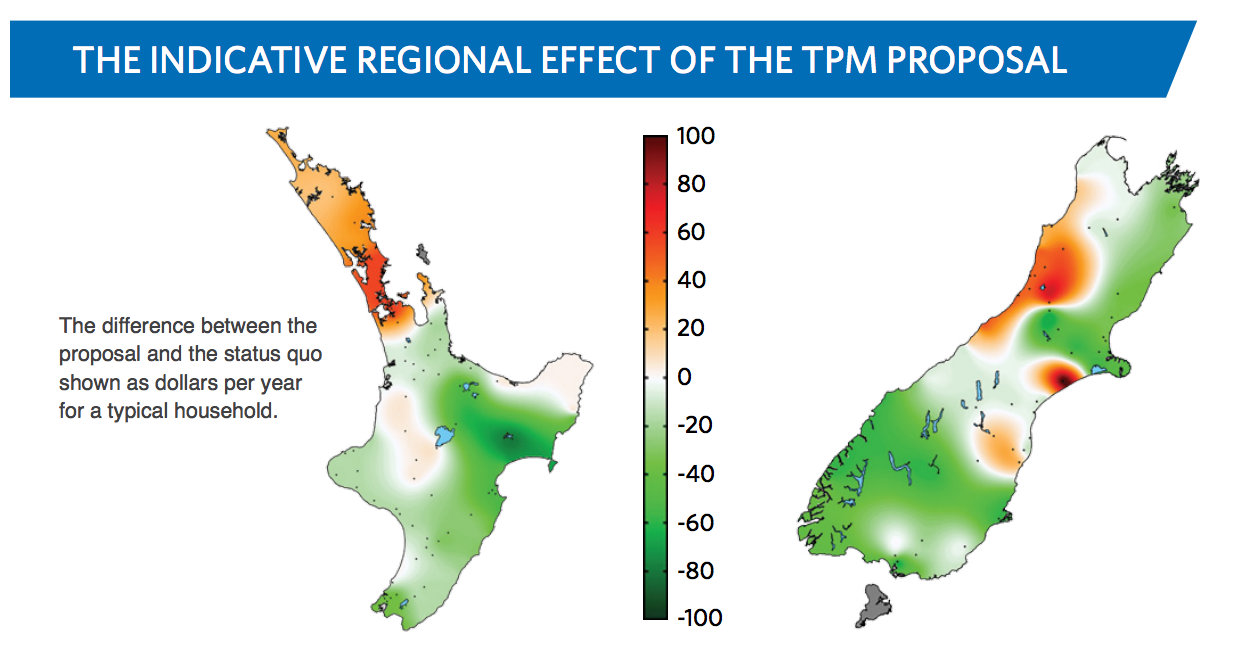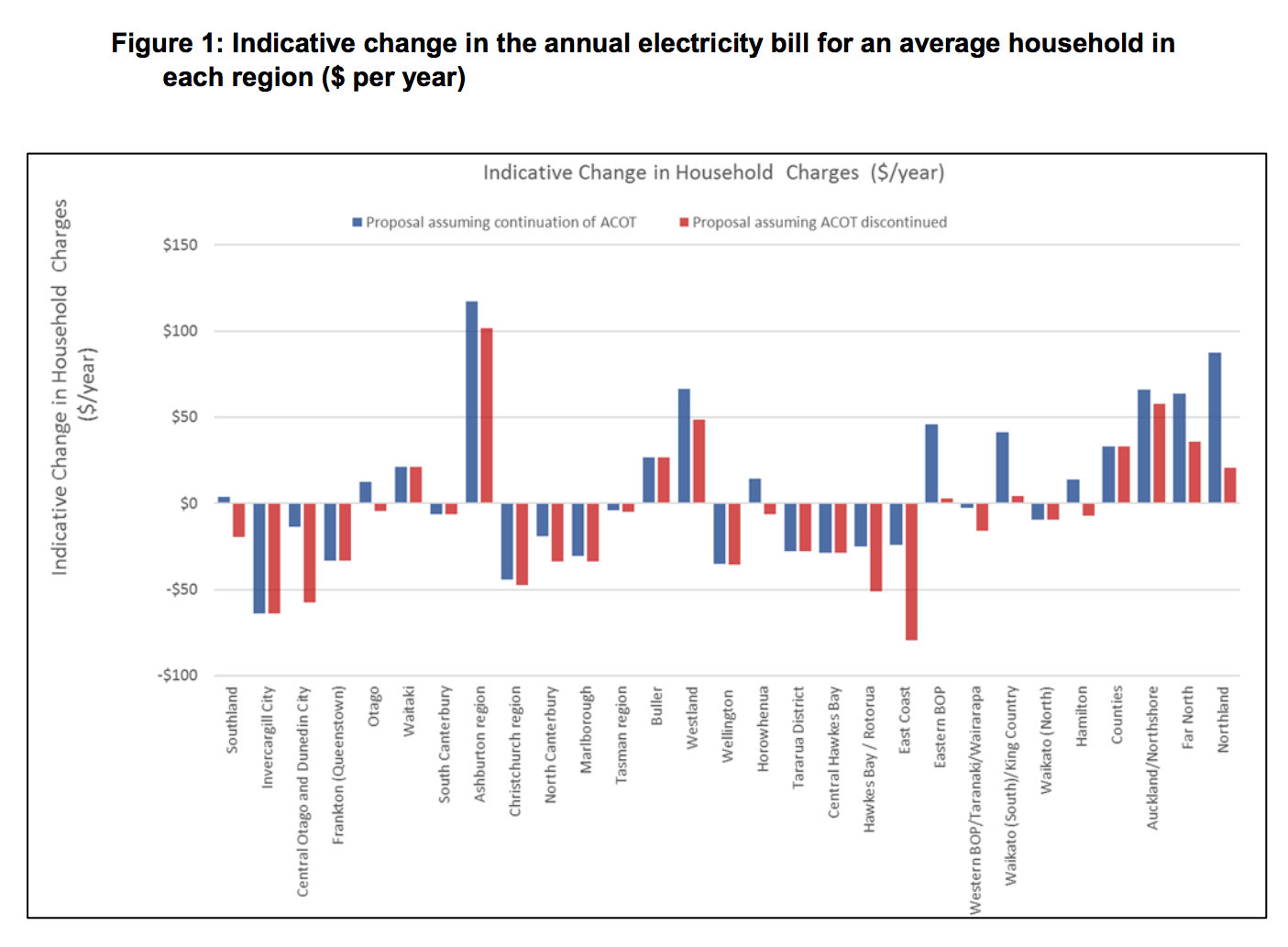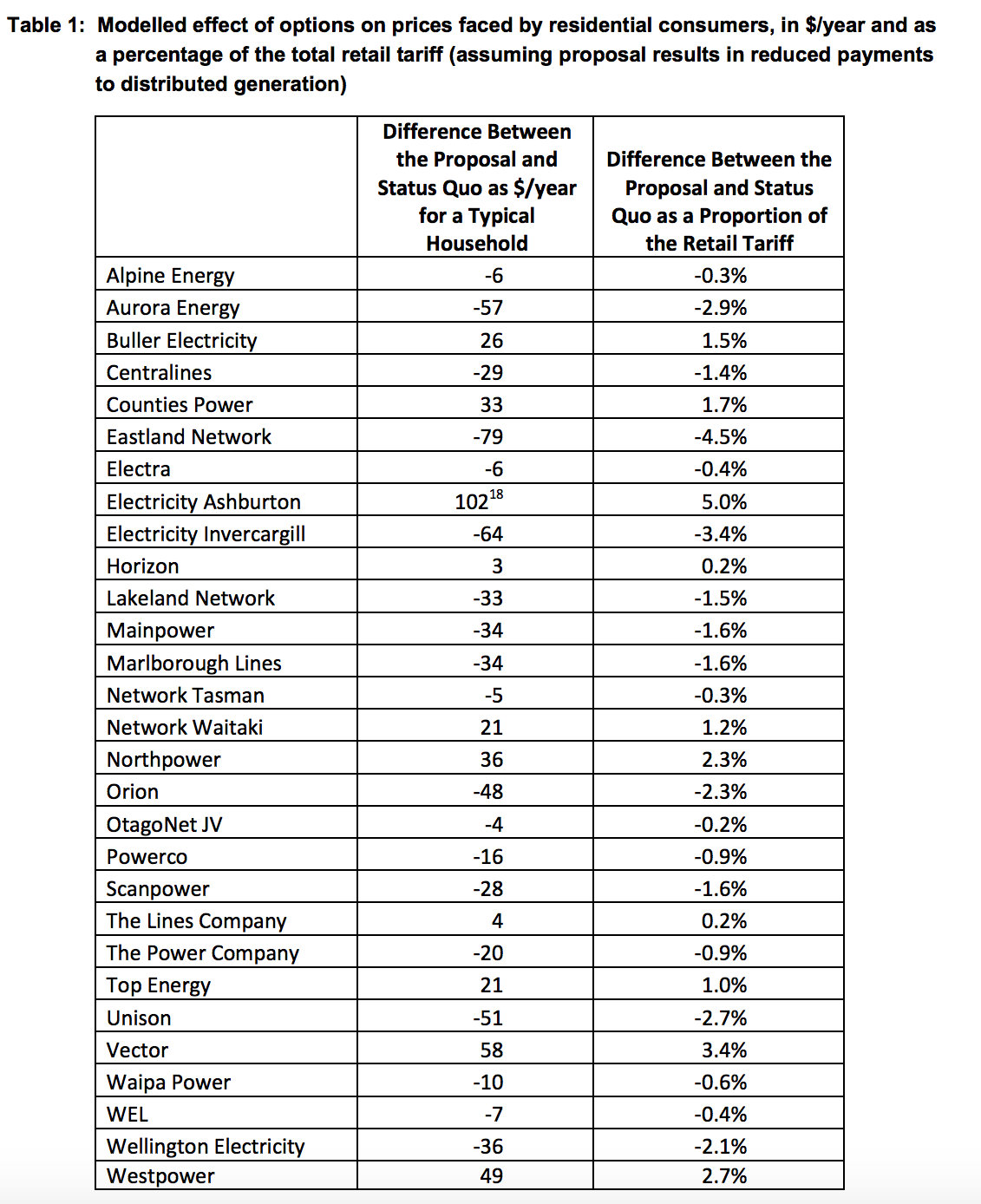
By Bernard Hickey
The Electricity Authority (EA) has proposed changes to the way transmission costs are paid for that would increase residential power bills by up to NZ$100 per year in Ashburton, Auckland, Northland and Westland, but lower charges in areas such as Invercargill, Nelson, Christchurch, Wellington and Gisborne by as much as NZ$50 per year.
The changes are also estimated to reduce the transmission costs for Tiwai Smelter owner NZ Aluminium Smelters (NZAS) by as much as NZ$21 million per year, and would also reduce transmission charges paid by Meridian Energy, which owns hydro-electric power plants in the South Island. Meridian Energy's share price rose 3.3% in morning trade.
The changes are proposed in two consultation papers on how the Authority sets pricing for the transmission of electricity on the national grid owned by Transpower, and for transmission on local electricity distribution networks, described as distributed networks.
The EA said the current Transmission Pricing Methodology (TPM) was complex and sent the wrong signal to power users.
NZAS and Meridian have lobbied for changes to the existing system, arguing they overpaid for improvements to the national grid in ways that benefited the North Island and other remote areas in ways those regions hadn't paid for. The changes in the transmission pricing regime were seen as crucial to the future of the Tiwai Point smelter. An earlier proposal had suggested NZAS' transmission costs could fall by more than NZ$50 million a year, so the NZ$21 million reduction may be disappointing for the smelter's owners Rio Tinto.
"The current TPM encourages wasteful use of the transmission grid, and investment in transmission and generation assets that is not in the best interests of electricity consumers and the New Zealand economy. The economic cost to New Zealand exceeds NZ$200 million," EA CEO Carl Hansen said.
"If no change is made, in the future consumers could pay hundreds of millions of dollars more for electricity than necessary," Hansen said.
The EA would replace the TPM and Distributed Generation charges with an ‘area-of-benefit’ charge, which would allocate the cost of a transmission investment to generators, distributors and industrial consumers located in areas of the country that benefited from the investment. A ‘residual’ charge would cover Transpower’s overhead costs and the cost of any grid assets not recovered by the area-of-benefit or other transmission charges. The residual charge would apply to distributors and industrial consumers only.
15 gainers and 14 losers
“Over time the proposal will reduce costs in the electricity industry and reduce prices for consumers from what they would otherwise be. The immediate overall impact of the proposal on the average residential electricity bill is fairly modest. In 15 regions, electricity consumers’ bills will decrease. In the remaining 14 regions, the average bill increase is less than $50 per year," Hansen said. (See more in the charts below)
“The regions where consumers will see an increase in their bills are those that have benefited from substantial recent grid upgrades to improve service levels, or where transmission prices have been lower than average. In every region, the benefit from these recent investments greatly exceeds the area-of-benefit charges proposed to pay for them," he said.
“Under the current TPM consumers that have had little or no benefit from these investments have faced higher costs of electricity to pay for them. Not surprisingly, this has made the current TPM contentious. The Authority believes that after an initial settling-in period, the new approach will improve the acceptability and durability of the TPM.”
Hansen said the EA believed consumers were paying distributed generators between NZ$25 million and NZ$35 million each year which they are not receiving any benefit in terms of reduced transmission costs. The EA estimated its proposal would mean consumers paid up to NZ$325 million less in charges than would otherwise occur over the first 15 years.
If adopted, the change would be phased in beginning 1 April 2017 and the changes would be phased in by April 2019.
Here some charts provided by the EA which describe how the changes would affect various regions, lines companies and big power users and generators.
Political reaction
Green Energy Spokesman Gareth Hughes said the proposals would force some households to pay more for power to subsidise big business users and make it even harder for families to warm their homes in winter.
“The fact is, higher power prices make for colder families and sicker children in winter,” Hughes said.
“The Electricity Authority should be treating the electricity network as a national asset for the benefit of all New Zealanders, not playing people who live in different regions off against each other while cutting the Tiwai Point aluminium smelter’s power bill by $20 million," he said.
“Allowing major industrial users more scope to ask for special discounts, which households will have to subsidise, is blatantly pitting the interests of big businesses against families having warm homes in the winter. Parts of the Electricity Authority’s document read like people will just up and move their lives around the country to maximise economic efficiency in the power grid, which is ridiculous."
Hughes also criticised the EA's proposals, which he said appeared to push back against a global trend towards distributed generation.
"The Electricity Authority seems to be trying to get New Zealand to go the other way by slashing the incentives to produce power locally," he said.
“Discouraging local distributed generation is likely to actually increase transmission costs in the long term, because we’ll have to keep paying to upgrade the lines to carry power in from far away."
New Zealand First attacked the proposal as guaranteeing the fat salaries of the big power companies.
“Instead of acting in the interests of all New Zealand the authority’s plan for power transmission charges disadvantages many Kiwis and ignores the obvious and fair solution – smoothing transmission line costs, that is, everyone pays the same price," NZ First's Fletcher Tabuteau said.
“This can be done by using the $194m plus in profits generated by Transpower. Instead, Kiwi households are paying the cost for its poorly considered infrastructure investment while foreign-owned Tiwai Point aluminium smelter is likely to benefit by reduced charges of $21 million," he said.
“We are all Kiwis, our forebears built the power stations, and we should all reap the benefits. Privatisation, the drive for profits and big salaries have ripped equality out of the power industry."




(Updated with political reaction)
16 Comments
Gotta go with Gareth Hughes here. This proposal is just BS. National should be shot for privatising it. They lied to the whole country. Not one of their promises came true.
Adding all those layers of profit was never going to work out. Every citizen ate a shit sandwich on this.
On the upside it looks like I'll get a lower transmission cost on my power bills. I've been scratching my head for a while as to why the cost is so high given so little infrastructure is needed where I live.
The old rationale was that Meridian and other southern generators would pay for HVDC upgrades to get access to the North Island market. The new theory seems to be that Auckland customers should pay more for access to southern generators.
Economists can debate the worthiness of any arrangement in terms of market purity. It just depends whether the company they work for gains or not from the change!
The thing which gets me is that this extra applies only to newly constructed projects. Why is that?
And let us not forget that when the HVDC upgrade project was being consulted upon, Meridian agreed that it should go ahead when it knew that it would have to pay a large chunk of its costs. It now wants the rules changed so that its costs go down and other parties pay more. Would those other parties (Auckland power users) have agreed for the HVDC project to go ahead if they knew that they would have to pay a large chunk of it? Who knows, it was commissioned a couple of years ago, so its too late to ask them. Although I guess that this consultation is doing something like that. But just like Len Browns rail tunnel, when things get momentum, even when they are a crock of shite, its hard to stop them.
Distributed distribution is the way of the future, and the setup should be to support this. The grid is a great national asset, there are great opportunities for us with newer technologies. So it needs to be owned and operated differently. Time to disestablish the line companies and set it up in a way that works for us.
Privatisation of life's essentials is a crime against humanity but.... The worst thing is people voted for this again. National had 9 years in opposition and did electricity prices come down under Labour? Nah! So... Next election what are we doing to put a stop to this?
It's like the NZ motto or something to never bring attention to yourself and protest or act with civil disobedience! Like we are all embarrassed to do so or fear losing our jobs? I just don't get it. Why don't we kick up a stink like they do in other countries when faced with corruption?
Yeah and when Labour couldn't stop it, David Parker out of spite sabotaged it. To the detriment of the general public due to the reduced returns.
Another subsidy for Tiwai Pt, which will keep Huntly and coal going because of this demand, not to mention the consumption of the 65000 or so extra immigrants each year(who will all want Teslas??)
Think I'll keep those MRP shares...
" the power companies, Meridian would save $57m under the new model, Contact $16m, Genesis just over $1m and Trustpower less than $1m."
Mighty River Power would have to pay an extra $4.1m.
Bugger
As far as Auckland and Northland are concerned this is all to pay for the completely unnecessary Waikato transmission upgrade. That cost could have, for example, built huge wind and tidal power generation in and around the Manukau. With that and the already in place gas fired peakers, increasing domestic solar and energy efficiencies generally Auckland should have had no need to import more electricity.
The Far North is already well on the way to sending power south with the consent for the 2nd and 3rd stages of development of the massive Ngawha geothermal field near Kaikohe.
It'll be sweet to say thanks but no thanks to 1000 kilometer power transmission.
The article does not explain how they will charge this extra amount. Will it be on a per kwh basis, or a daily charge? Why do I suspect it will be a daily charge basis, which gives no incentive to reduce power consumption, but guarantees the power companies income? A daily charge is unavoidable.
All are mechanisms of a well controlled oligopoly working 100% on behalf of the generators/ transmitters and shafting the consumers.
It has two components in its existing form a daily charge and the network cost is a large portion of the per kW.h charge. I assumed it would reduce the per kW.h cost as that's about 7 times larger than the daily charge.
Sorry I'm also looking at it from the perspective of that the charge will reduce for me. If you are in Auckland or one of the other areas I suspect your per kW.h costs are going to increase a lot.
Then it would be no shock if they reduced your kwh charge, but increased my daily charge, because that is what a monopoly may well do. Maximise their daily compulsory charges, reducing to some extent the variable charges; thereby keeping any wishful competitors out.
It would be rather like a monopoly supermarket charging everyone $150 a month just for it being there, based on its capital cost and rent, and knowing that everyone had to use it from time to time, but then charging moderately competitive amounts for the groceries. Supermarkets are of course not monopolies, which is why they cannot price like that, but power companies effectively act as one, which is just one of the reasons their sale was probably the worst economic decision by any government this century.
In any case in time someone will explain exactly how they will relieve us of this extra money.
"Over time the proposal will reduce costs in the electricity industry and reduce prices for consumers from what they would otherwise be."
Sounds good to me!
The tooth fairy sounds good to me too.
"over time".
What that means in terms of power station development (in this low load increase environment) is maybe 10 yrs time. And at that point the theoretical benefit will start out minuscule. ie requiring an electron microscope to see it.
Yeah, I used to think the same as you, but in the spirit of 'you are only as good as your last game' I have to say the Tooth Fairy has been off my christmas card list for some time now.
They are very selective in how the Commerce Commission polices the rules. Generators and Transpower can pretty much charge what they like but the local lines companies are screwed down so tightly that it is undermining the ongoing health of the network eg Vector.

We welcome your comments below. If you are not already registered, please register to comment
Remember we welcome robust, respectful and insightful debate. We don't welcome abusive or defamatory comments and will de-register those repeatedly making such comments. Our current comment policy is here.